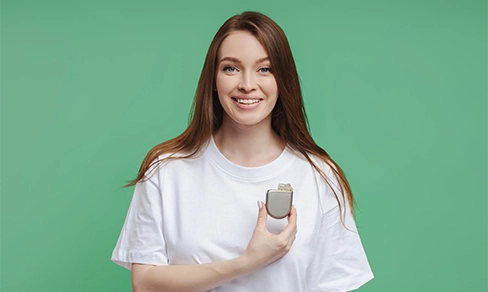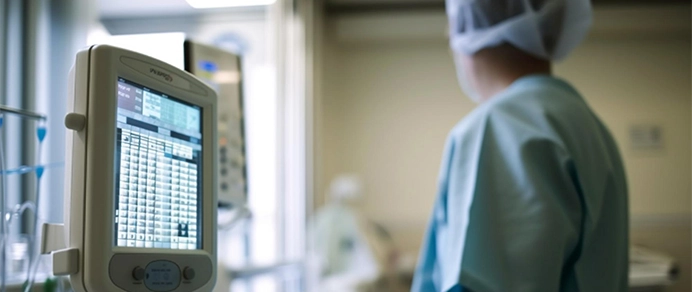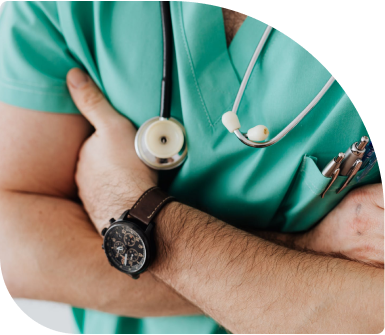— Procedures
Internal Defibrillators (ICDs)
Internal defibrillators are small devices that are implanted into the chest.
Internal Defibrillators Explained
Internal defibrillators are small devices that are implanted into the chest. They can monitor heart rhythm and deliver a small electric shock if your heart develops a dangerous rhythm problem.


- What is an internal defibrillator?
- How do they work?
- Why might I need an internal defibrillator?
- How would you fit my internal defibrillator?
- What happens during the procedure?
- What happens next?
- Will I feel the electric shocks?
- What should I do if my device gives me an electric shock?
- What else do I need to be aware of?
- Will I be able to drive after I’ve been fitted with an ICD?
- Will I need to see you again in the future?
- What happens when my internal defibrillator’s battery runs out?
What is an internal defibrillator?
Most people are familiar with the idea of defibrillators: external versions have become a common sight in our public spaces. An internal defibrillator is like a miniature version of these much larger devices. It’s a small, battery-powered pacemaker device that sits in your chest and connects to your heart with wires (also known as leads). Like a public defibrillator, it can deliver lifesaving electrical treatment to your heart if you develop a rhythm problem. Internal defibrillators are also commonly known as implantable cardioverter defibrillators (ICDs).
How do they work?
Internal defibrillators constantly monitor and record your heart rate and rhythm as you go about your daily routine. If they detect a problem, they can deliver electrical pulses to correct the issue; for example, your device could give you:
- Extra heart beats (known as “bradycardia pacing”) – if your heart rhythm is too slow
- A short surge of beats (“anti-tachycardia pacing”, or ATP) – if your heart is beating too fast
- A stronger pulse or shock – if the ATP doesn’t correct the issue, or if you have developed a life-threatening condition called ventricular fibrillation
ICDs have different functions and settings. We can change these at the clinic and monitor your device by connecting wirelessly to your device if we need to.
Why might I need an internal defibrillator?
ICDs are usually recommended for people who have a serious underlying heart condition, or who we think may be at high risk of developing a life-threatening problem with their heart. Some of the conditions we can treat with ICDs include:
- Ventricular tachycardia (VT) – an unusually fast heartbeat that starts in the ventricles (lower chambers of the heart)
- Ventricular fibrillation (VF) – a serious rhythm problem caused by disorganised electrical activity in the ventricles
- Inherited cardiac disorders – genetic problems that increase the risks associated with rhythm problems (such as Brugada syndrome or long QT syndrome)
See also: What is happening in a heart with arrhythmia?
How would you fit my internal defibrillator?
Most ICDs are fitted using “transvenous implantation”, which means the leads are inserted through one of your veins. We do this by creating a small incision underneath your collarbone (about 5cm wide), usually on the left side. We then direct the leads to your heart, guided by an x-ray scanner. While some ICD operations are performed with a general anaesthetic, the majority are done using a local anaesthetic, often with a sedative to help you feel relaxed.
What happens during the procedure?
When you arrive at the clinic, the nurses will give you an assessment and go through your details. We’ll then take you to the theatre, where you’ll receive some antibiotics and sedation (or a general anaesthetic). Before the procedure starts, we’ll clean the skin around your collarbone with antiseptic. If you’re staying awake for the operation, we then inject a local anaesthetic to numb the area. After making the incision, we will insert the lead/s and connect them to your ICD. The device will usually be positioned below the skin in your chest. We then seal the incision with medical stitches. The operation usually takes around 60 to 90 minutes to complete.
What happens next?
Immediately after the procedure, you’ll be taken back to the ward so you can lie down and rest for an hour or two. We’ll do some tests to check your device is working well and make sure it’s adjusted to the best settings for you. We may also monitor your heart rhythm with an ECG. Back at home, you will probably need to take painkillers for the first few days as your wound heals; we may provide you with a course of antibiotics too. You should aim to keep the wound dry for the first few days after your surgery, and let us know if you’re worried about it. After approximately six weeks, we’ll see you again for a follow-up appointment to check your device is still functioning well.
Will I feel the electric shocks?
Clearly, ICDs are designed to deliver electric shocks to your heart in certain circumstances. How this feels can vary; it also depends on the type of shock you receive. If your ICD releases a pulse treatment for a fast or slow heartbeat, for instance, you may only be slightly aware of it, or not at all. If your device delivers a high-energy shock to correct a dangerous change in the heart, you’re much more likely to notice it. Most people feel this type of shock as a thud, kick or thumping sensation in their chest. This can be unpleasant, uncomfortable and sometimes quite painful. While it’s natural to worry about the idea of receiving an electric shock to your heart, however, the key thing to remember is that the device is working to protect you by treating any rhythm problems as soon as they happen. The shock usually only lasts for less than a second. Some people feel minor aches in their muscles after an ICD shock. If someone is touching you when you receive a shock, they may possibly feel a small jolt too, but it won’t be harmful for them.
What should I do if my device gives me an electric shock?
Some people experience symptoms shortly before the shock occurs. These can include palpitations or dizziness. If you sense that you’re about to receive a shock from your ICD, it’s a good idea to sit down, or lie down on the floor, and ask for help if someone else is nearby. In many cases, though, symptoms can come on very quickly, or you may not be aware of them at all.
Although most people recover quickly from an ICD shock, it’s important to follow-up the incident afterwards:
- Feeling well? Call 0876221793 (in hours) or the main hospital switchboard out of hours so they can advise you what to do next, even if you’re feeling completely fine. You should also call the implant centre to arrange a device check
- Feeling unwell? Call 112 or 999 for an ambulance; make sure you or someone with you tells the doctors that you have an ICD fitted, and take your device ID card with you (see below)
- Received several shocks? Ask someone to take you to the nearest hospital, or call 112 or 999 for an ambulance
What else do I need to be aware of?
Internal defibrillators save lives but, as with many medical procedures, they also come with potential risks. Around five percent of patients develop a complication after an ICD fitting. Though rarely dangerous, these can range from bruising to the tissues surrounding the device to blood vessel damage or a dislodged lead. As with any surgery there is also a small risk of infection. Since internal defibrillators are programmed to protect you by reacting to potentially dangerous rhythm changes, they can sometimes discharge unnecessarily. Again, this is relatively rare – estimates are that around one or two ICD patients in every 100 will receive a shock from their device that they didn’t need.
There are a few other things that are useful to know when you’re preparing to have an internal defibrillator:
- ID card – every pacemaker comes with a card listing the device’s make and model, so the relevant medics can be properly informed if you need treatment in the future. You’ll receive this card before or soon after you leave the hospital and you will need to carry it with you at all times.
- Car insurance – you’ll need to let your insurance know when you’ve had an ICD fitted
Household equipment – most household devices shouldn’t interfere with your device, though the small print on products sometimes states you should avoid using them if you’re fitted with a pacemaker device; if you’re unsure, check with us. However, you should avoid placing magnets near your chest, because they can interfere with your ICD. (Also be aware that certain devices, such as stereo speakers, can contain strong magnets.) - Mobile phones – we usually recommend you don’t carry your phone in a pocket near the ICD, or use it within six inches of the device, since there is some evidence that some phones can affect them.
- Medical scans – it’s safe to have x-rays, mammograms and CT scans while you have an internal defibrillator, but depending on your device you will probably need to avoid having an MRI scan; again, you can contact us for advice if you need to.
- Travelling – if you have to pass through an airport security scanner, it’s a good idea to show the officials your device ID card as you do so; the metal in pacemakers sometimes triggers the security alarms (though it won’t cause any harm to the device).
We’ll give you more comprehensive information about the Dos and Don’ts for your device before you leave the hospital.
Will I be able to drive after I’ve been fitted with an ICD?
There are various restrictions around who is deemed safe to drive after a pacemaker device has been implanted, and when you would be able to resume driving. These will depend on the reason you needed to have a pacemaker or defibrillator, so it’s important to discuss this with us in detail. You can also find more information about driving and defibrillators/pacemakers on the Road Safety Authority’s (RSA) website.
It’s important to know that, if you receive an electric shock from your device, you may not be permitted to drive for some time afterwards. The exact amount of time depends on whether the shock was delivered in response to a genuine, serious rhythm problem (this is known as an “appropriate shock”) or if it fired off unnecessarily (an “inappropriate shock”). In the first case, you’d generally need to wait for six months before resuming driving. For an inappropriate shock, it’s usually a month after the shock has been identified and (if necessary) fixed.
Will I need to see you again in the future?
Yes. Your ICD will need to be checked regularly in the hospital – at least once a year, or potentially more frequently. During the checks we’ll review your device’s settings and battery life, and use some specialised tests to examine the condition of the leads. We may then make some adjustments if they’re necessary. It’s now also possible to do some checks remotely using a home transmitter; data about the device and your heart rhythm can be sent over the internet for us to review. If we think you’ll be suitable for a portable monitoring device, we can discuss this with you in hospital or in the clinic.
What happens when my internal defibrillator’s battery runs out?
All batteries eventually run out, but we’ll give you plenty of warning before this happens. Modern ICD batteries also last a long time – usually around six to 12 years, depending on the type of device. The operation to replace a battery is similar to your original fitting, except that we won’t normally need to replace the leads running down to your device.
Patient’s thoughts

Jonathan’s Expertise
Common Questions
Book a Consultation
Reach out and book a consultation with Jonathan.
Expert TREATment
Heart Conditions
Experience expert treatment for heart conditions, with personalised care and advanced technology with Jonathan Lyne Heart Rhythm Cardiologist.
Extra heartbeats, usually harmless, occasionally need further investigation for caution.